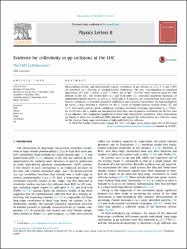Evidence for collectivity in pp collisions at the LHC

View/
Access
info:eu-repo/semantics/openAccessDate
2017Author
Khachatryan, V.Sirunyan, A. M.
Tumasyan, A.
Adam, W.
Asilar, E.
Bergauer, T.
Özdemir, Kadri
CMS Collaboration
Metadata
Show full item recordAbstract
Measurements of two- and multi-particle angular correlations in pp collisions at root s = 5, 7, and 13TeV are presented as a function of charged-particle multiplicity. The data, corresponding to integrated luminosities of 1.0 pb(-1) (5 TeV), 6.2 pb(-1) (7 TeV), and 0.7 pb(-1) (13 TeV), were collected using the CMS detector at the LHC. The second-order (v(2)) and third-order (v(3)) azimuthal anisotropy harmonics of unidentified charged particles, as well as v(2) of K-S(0) and Lambda/(Lambda) over bar particles, are extracted from long-range two-particle correlations as functions of particle multiplicity and transverse momentum. For high-multiplicity pp events, a mass ordering is observed for the v(2) values of charged hadrons (mostly pions), K-S(0), and Lambda/(Lambda) over bar, with lighter particle species exhibiting a stronger azimuthal anisotropy signal below pT approximate to GeV/c. For 13 TeV data, the v(2) signals are also extracted from four- and six-particle correlations for the first time in pp collisions, with comparable magnitude to those from two-particle correlations. These observations are similar to those seen in pPb and PbPb collisions, and support the interpretation of a collective origin for the observed long-range correlations in high-multiplicity pp collisions. (C) 2016 The Author. Published by Elsevier B.V. This is an open access article under the CC BY license.
















